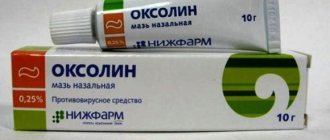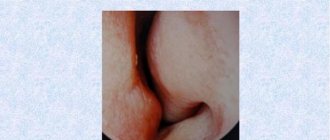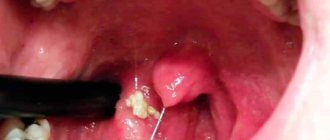Yellow nasal discharge: main causes
In what cases does yellow liquid flow:
1
Cyst. Yellow-orange amber-colored snot is a sign of a cyst in the sinuses. This formation is a cavity of different sizes, which is limited by walls. With straining, excessive nose blowing and other physical efforts, such a cyst ruptures and bursts.
In these situations, the person leaks orange water, which greatly frightens him. Such a ruptured cyst does not pose a threat to health. Its walls subside, but after a while it fills up again and the episode of orange liquid flowing out of the nostril will repeat.
2
Chronic processes in the cavity and sinuses. Sluggish inflammatory diseases of this area may not manifest themselves in anything other than yellow-green snot in an adult, which bothers mainly in the morning.
3
Allergy. Various types of allergens cause clear, watery fluid to appear. This is a specific vascular reaction to the entry of a foreign substance into the body. After a few days, a bacterial infection joins this process and the clear discharge will become amber in color.
4
Long-term smoking. Tobacco and its impurities, deposited on the mucous membrane of the pharynx, cause the appearance of such mucus.
5
Application of some drops. Some people prefer to prevent pathology in the early stages and use and instill various preventive and therapeutic agents, for example, Protargol.
Mixing with natural mucus, such drops color it in different shades. After which patients often observe yellow-brown discharge from the nose.
Why is snot yellow?
Ordinary acute rhinitis almost always occurs in several stages:
- At first, there is no discharge at all, and the patient is only concerned about dryness, burning and itching.
- Then the mucous membrane begins to actively fight pathogenic bacteria and viruses, which causes a characteristic vascular reaction and the appearance of transparent mucus.
- At the third stage, typical greenish-yellow discharge appears.
- During the recovery period, the runny nose stops and the mucous membrane begins to work normally.
At a certain stage, the immune system destroys microorganisms that cause inflammation. In addition, the death of immune system cells that were thrown to fight inflammation occurs. Fragments of viruses, bacteria, dead leukocytes, red blood cells - all this gives the specific shade of mucus. This phenomenon is usually called pus.
Phases of a runny nose
Many people believe that snot is pus itself, but this is not true. Snot is 95% water, 1% salt and 3% mucin protein. In addition, snot may contain a small amount of nucleic acids and epithelial cells. It is the mucin protein that gives snot its viscosity and thickness. This protein is an excellent bactericidal agent and effectively helps fight infection.
Mucin is produced constantly, regardless of the presence or absence of a cold. There is always a certain amount of snot in the nose of a healthy person, which moistens the nasal mucosa. This lubricant prevents bacteria and dust from entering the body. When the air contains a large amount of moisture, mucin begins to be produced in greater quantities upon contact with it, which is why snot begins to flow in the cold.
A runny nose (pathological discharge) has several phases:
- Dry rhinitis. The virus is already multiplying with might and main on the surface, but the mucous membrane is not yet secreting a secretion. Due to dryness, the receptors are irritated, the person sneezes and feels discomfort in the nose.
- A liquid and transparent secretion begins to stand out. It must fight viruses, moisturize the mucous membrane well and remove infectious particles from the body.
- Purulent rhinitis is a runny nose with purulent discharge. If a person has good immunity, this secretion includes cells that fight infections. But if victory is on the side of infection, then pathogenic bacteria can be found in the snot.
Yellow snot in an adult
Discharges of this type are nonspecific and can be a sign of a whole list of diseases. What reasons most often cause this symptom:
Common runny nose.
With this pathology, under the influence of various pathogenic bacteria, the mucous membrane becomes inflamed. Along with swelling and nasal congestion, a person also develops this kind of discharge. Sinusitis and other types of sinusitis. An inflammatory process in the sinuses almost always accompanies this problem. Thick yellow nasal discharge in an adult occurs with any type of sinusitis: frontal sinusitis, ethmoiditis, sinusitis or sphenoiditis. Cold. With such problems, viscous, transparent mucus first appears. After a few days, a bacterial infection occurs, which becomes the cause of yellow-green snot in an adult. Viral infections. Many viruses that enter the nasopharyngeal mucosa cause not only the appearance of liquid yellow discharge. They very often have a damaging effect on the wall of blood vessels. Source: nasmorkam.net This leads to rupture of small capillaries. In such cases, very yellow snot with blood is often observed.
These diseases are usually accompanied by cough, sputum and other signs of inflammation of the respiratory tract. Inflammation of the adenoids. This tonsil, located at the posterior fornix of the nasopharynx, most often becomes inflamed in childhood; adults rarely suffer from this problem. Adenoiditis causes a person to develop a dark yellow discharge that constantly flows down the back of the throat. Rhinolit. What it is? This is a foreign body in the nostril that calcifies and becomes a site of chronic infection. Occurs mainly in children or the elderly. It appears as discharge from one half of the nose. You can find out what such a symptom means and what causes its appearance only by studying the patient’s medical history and conducting a detailed examination.
Treatment of a runny nose
How to cure a purulent runny nose is decided depending on the cause of its occurrence and the results of the bacteriological culture analysis. In adults, the treatment process most often begins with the doctor rinsing the patient’s nose with saline solutions or special medications based on sea salt. After rinsing, the swelling of the mucous membrane decreases, the discharge from the nose becomes more liquid, and the microbes die.
If there is a purulent process, then local antiseptics are added to the saline solutions, which do not cause irritation of the mucous membrane, but are effective. These include Miramistin, Furacilin, Chlorhexidine. In some cases, hydrogen peroxide is used. As a rule, after rinsing the nose, the number of pathogenic flora is reduced and the unpleasant odor disappears. Recovery soon follows.
When diagnosed with “purulent runny nose,” effective treatment is impossible without vasoconstrictor drops. However, you need to know that such drops can be used for no longer than a week, otherwise addiction will develop. If vasoconstrictor drops do not have the desired effect, the doctor prescribes hormonal sprays, for example, Nasonex or Avamis. They are used when the swelling is too severe and normal fluid outflow is impossible. Sprays are prescribed along with antibacterial drugs to prevent the bacterial infection from becoming more active.
Purulent snot
Obvious suppuration always indicates a bacterial infection. In what situations does this phenomenon occur most often:
1
Sinusitis or frontal sinusitis. People often wonder what color the snot is when they have sinusitis. It depends on the stage of the disease and the pathogen. So, with odontogenic maxillary sinusitis, they smell like pus. And with a bacterial infection, snot with pus is released from a person so abundantly that it flows from both the nostrils and the throat.
2
Colds and viral infections. The second most common cause of purulent discharge. In this case, the patient is worried about fever, cough, weakness and other symptoms of intoxication.
3
Ozena (fetid rhinitis). During this atrophic process, characteristic purulent-yellow crusts with an odor appear in the cavity, which is felt by both the person himself and the people around him.
Important
One of the causes of this symptom is cancer of the nasopharynx or sinuses. Moreover, in the early stages of the disease there are no other manifestations, except for such periodic specific mucus, which is not associated with either a cold or infection.
Causes of purulent rhinitis
Purulent rhinitis can appear for several reasons, but mainly bacteria are involved in its development, which secrete their toxic waste products in the nasal mucosa. It is after the death of such bacteria that purulent nasal discharge with an unpleasant odor appears. The following factors can cause rhinitis in adults of purulent origin:
- illiterate or untimely treatment of acute rhinitis due to a cold;
- hypothermia of the body;
- infectious diseases (acute respiratory infections, acute respiratory viral infections);
- respiratory tract diseases;
- hay fever;
- decreased immunity;
- severe infectious diseases (diphtheria, measles, etc.).
Often, purulent rhinitis can be provoked by problems with blood circulation, chronic diseases of the ENT organs, and prolonged stay in a dusty or smoky room. Regardless of the cause, snot with pus is not an independent disease, but only a symptom or complication of another pathology of the ENT organs.
How to treat?
To cure a pathology, its cause must be clearly established. If this problem appears with a runny nose and the patient’s health is fine, then this is a sign that it has entered the final stage and does not require a change in treatment.
It is necessary to treat sinusitis and other inflammation of the sinuses, which is accompanied by such discharge and other symptoms of intoxication, more seriously. What they use:
1
Antibiotics. A course of antibacterial drugs of the penicillin or cephalosporin series is prescribed. For allergies, they resort to macrolides.
2
Antipyretic and anti-inflammatory drugs. They help relieve pain and improve the patient’s well-being.
3
Antihistamines. Used to relieve swelling.
4
Immunocorrectors are prescribed to patients with weakened immunity and when fungal microflora is attached.
5
Mucolytics. When a person is bothered by sticky, thick, difficult-to-clear discharge, this group of medications is prescribed to help remove it from the body. This group of medications helps a lot when the snot is not blown out.
In addition to systemic therapy, the disease is treated with local drugs:
- Drops and sprays. Various types of these agents are used, both antibacterial ones such as Isofra, and vasoconstrictors, to simply remove swelling and symptoms.
- Creams and ointments. They are used less often. Antibacterial and anti-inflammatory medications are placed in the nostrils.
- Rinsing independently or in a doctor’s office (ENT procedure “Cuckoo”).
Additionally, physiotherapy procedures selected by a specialist are prescribed, for example magnetic laser therapy.
Important
If there is purulent discharge, it is highly not recommended to perform thermal procedures, or visit a sauna or bathhouse. The effect of such treatment will be the spread of infection and the development of life-threatening complications.
Nasal discharge during pregnancy
The occurrence of periodic watery discharge and swelling during pregnancy is considered one of the normal variants. This is the so-called vasomotor rhinitis of pregnant women , which goes away on its own after delivery.
Yellowness in mucus from the nostrils is not normal. The immunity of a pregnant woman can be significantly reduced, especially in the first trimesters, and against this background colds often develop and chronic processes worsen.
The appearance of such a symptom and other signs of the inflammatory process: fever, cough, sore throat should be a signal to begin serious therapy in order to prevent the development of complications.
Many women have no reason to fear, even in this exciting period, there are medications, in particular antibiotics, drops and others, that help cope with the disease and not harm the unborn baby. To do this, you need to visit a specialist and choose a treatment regimen together.
Bright yellow snot
What do such discharges in humans indicate? It all depends on the other symptoms that accompany this phenomenon. They can also be a manifestation of an infectious process. When the mucous membrane actively fights bacteria, they die and come out in the form of such a pathological secretion.
If nothing else bothers a person, then rhinitis and bright orange fluid from one nostril may be a sign of a ruptured cyst. This formation comes in different sizes and most often does not manifest itself in any way, remaining in the sinuses for a long time.
Under certain circumstances, such cysts burst and the fluid contained in them comes out.
A one-sided runny nose occurs when foreign bodies appear in the nostrils. This most often occurs in children, but sometimes it happens to a person of any age who likes to put foreign objects in there.
Clinical example: patient M., 35 years old, complained of unilateral discharge with an unpleasant odor. According to the patient, this symptom has been bothering her for a month now. Rhinoscopy revealed discharge and deviated septum in the nasal passages, the mucous membrane was swollen and hyperemic.
When examining the cavity using an endoscope, it was possible to detect a foreign body in the area of the superior turbinate (a clove of garlic). The patient remembered that several months ago, she treated a cold using this folk method. The foreign body was removed and the woman recovered.
Bright yellow discharge is sometimes a sign of frontal sinusitis, sinusitis, or inflammation of another sinus. To clarify the cause, a detailed examination and examination is needed.
Symptoms of purulent runny nose
The clinical picture of this pathology is manifested by purulent snot, nasal congestion, unpleasant (fetid) odor of discharge from the nasal cavity, changes in taste and smell, headache, pressure in the forehead. The smell of pus in the nose is one of the most striking symptoms, which indicates the decomposition of dead microorganisms that caused a purulent inflammatory process.
A purulent runny nose is characterized by a greenish color of discharge, which almost always signals a possible danger. Moreover, the discharge is often thick and does not come out well, so it requires additional liquefaction.
Often a purulent runny nose is accompanied by general symptoms: weakness, apathy, sleep disturbance, irritability, lack of concentration, poor sleep.
A purulent runny nose in a child, especially in children under 5 years of age, is aggravated by a significant increase in body temperature. The mark on the thermometer often exceeds subfebrile values, i.e. becomes above 38 degrees.
What is used for diagnosis?
A carefully collected medical history, examination of the patient, and laboratory and instrumental methods help the doctor make a diagnosis. The specialist clarifies how long this phenomenon has been troubling and what the person himself associates its occurrence with.
After this, the doctor begins an examination, paying attention to the anatomical structure and the presence of pathological formations. For a detailed examination, endoscopic equipment is used.
X-rays, CT or MRI help to study the sinuses. General clinical tests allow one to suspect an inflammatory process in the body. Allergy tests make it possible to establish sensitization to allergens.
How is diagnosis done?
To determine how to treat purulent snot, it is necessary to conduct a differential diagnosis and clarify what we are dealing with. This is simply purulent rhinitis without complications, or perhaps the disease has already been complicated, for example, by sinusitis. Also, purulent snot can appear with a maxillary sinus cyst. An article on the topic of how to quickly cure sinusitis at home.
The otolaryngologist questions the patient in detail about the symptoms that bother him, performs a rhinoscopy, and, if necessary, prescribes additional studies. This may include x-rays, computed tomography (CT), bacterial culture of nasal discharge, general blood and urine tests, and endoscopy of the nasopharynx.
It is much more difficult to collect anamnesis from a child, because the baby may not answer the questions clearly or completely mislead the doctor, so the ENT specialist immediately pays attention to the color of the snot, whether it is purulent or normal.
When general intoxication appears, one can immediately suspect the spread of infection into the paranasal sinuses, but only an X-ray or CT scan can clearly confirm the diagnosis. With sinusitis, pain occurs, and the more intense it is, the worse the discharge leaves the inflamed cavities.
Important! With a common cold, viral infection, allergic and vasomotor rhinitis without complications, there cannot be pus in the snot. Only bacteria cause pus and unpleasant odor in the nose. Therefore, if such symptoms appear, immediately sound the alarm and urgently visit an ENT specialist.
On a note! In rare cases, the patient may become hostage to a disease such as ozena (atrophic purulent rhinitis), which is a chronic form of purulent rhinitis. A characteristic feature of this disease is a strong foul odor of nasal discharge, the presence of purulent crusts and mucosal atrophy.
If not treated in a timely manner, purulent snot becomes the culprit of such diseases as tonsillitis, tonsillitis, otitis media, tracheitis, bronchitis, and others. A timely diagnosis and proper treatment will eliminate the disease in the acute period and reduce all chances of acquiring a chronic infection in the nasopharynx.
How to treat herpetic sore throat in children.
How to treat yellow snot?
This problem can be cured only by knowing its cause and applying an integrated approach. How to treat the disease depends on the diagnosis. So, to eliminate rhinolitis, surgical intervention is performed if the foreign object is firmly attached to the mucous membrane.
Treatment of inflammatory diseases such as sinusitis, adenoids, and advanced runny nose requires treatment with conservative agents.
Patients are prescribed antibiotics, decongestants and anti-inflammatory medications. Drops and sprays are used locally. Use washing and rinsing with moisturizing, saline and antiseptic solutions.
In cases of complications of sinusitis, sinus puncture or even surgery is recommended. When such a discharge develops as a result of an improper microclimate in a living room or prolonged smoking, then a change in lifestyle is enough for the disease to go away on its own.
Chronic processes in this area require a thorough diagnosis and study of the microflora and its sensitivity to drugs. Only in this case is it possible to achieve stable remission of the disease.
For allergic rhinitis, they try to eliminate contact with the causative allergen. The patient is also given symptomatic therapy that will help alleviate the course of the pathology. When a bacterial infection occurs, antibiotics and anti-inflammatory drugs are added to the course of treatment.
ethnoscience
Treatment with folk remedies works well in a complex therapy regimen or outside of exacerbation in chronic processes. In case of severe inflammation, the use of exclusively folk recipes only worsens the situation.
A good effect can be achieved by inhalation: steam or using a nebulizer. Steam inhalations are performed with decoctions of medicinal herbs and essential oils. This type of procedure is prohibited for children. [ads-pc-1][ads-mob-1] For this category of young patients, inhalations using a nebulizer are used. In the treatment of a runny nose, saline solution or medications with antibacterial and mucolytic effects are sprayed into it.
To get rid of this scourge, you should use proven folk remedies prepared at home:
1
Drops based on Kalanchoe and chamomile. Add a teaspoon of Kalanchoe juice to half a glass of chamomile decoction. Instill such drops 2-3 times a day, using a whole pipette, for a week.
2
Place 1-2 drops of thuja oil into your nostrils. This medicine will ease nasal breathing, relieve congestion and disinfect inflamed mucous membranes.
3
Rinsing with saline liquids, decoctions of medicinal herbs or a weak solution of baking soda.
4
A decoction of linden flowers (a tea boat of dried flowers is brewed in two glasses of boiling water and left for half an hour) is mixed with honey and drunk several times a day. This tea strengthens the body's natural defenses.
Attention
Some popular recommendations are absolutely not suitable for treating such snot. Thus, heating with boiled eggs or bags of hot salt causes the spread of the purulent process and the development of complications.
Yellow and green snot in an adult are the result of various diseases. To select an effective treatment, you need to establish the cause of the disease and select the right remedies. The key to successful therapy is compliance with the requirements for the duration of medication use and a certain regimen.
Traditional methods
Drug treatment of purulent rhinitis is supplemented with proven home recipes. The use of such compositions is of an auxiliary symptomatic nature, aimed at facilitating breathing, improving general well-being, and caring for the nasal mucosa.
It is recommended to rinse the nasal passages with infusions of medicinal herbs - chamomile, St. John's wort, sage. To prepare them, you need to pour 15 g of dry plant material with 250 ml of boiling water, leave for half an hour, strain, and cool.
Kalanchoe juice (not diluted) and aloe (mixed with water 1:2) are instilled into the nose, 2 drops three times a day. Onion juice is combined in equal parts with peach oil, 2 drops of the product are instilled into each nostril 3 times a day.











